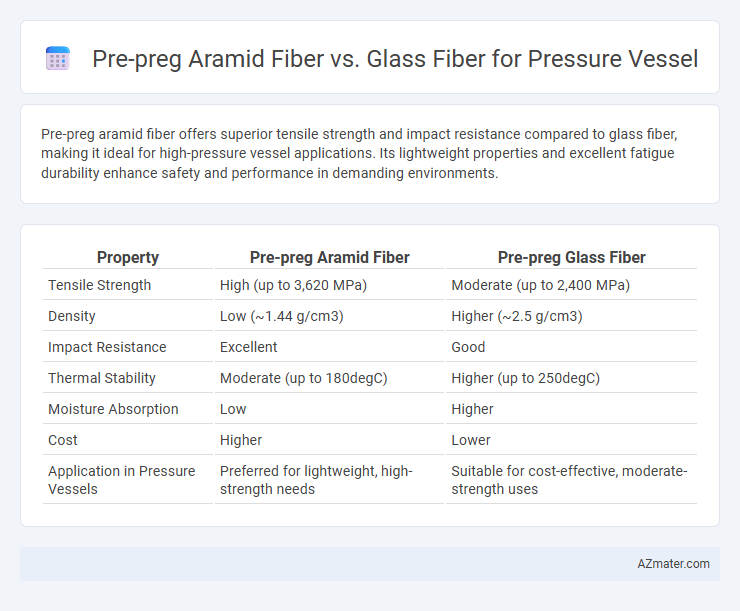Pre-preg aramid fiber offers superior tensile strength and impact resistance compared to glass fiber, making it ideal for high-pressure vessel applications. Its lightweight properties and excellent fatigue durability enhance safety and performance in demanding environments.
Table of Comparison
| Property | Pre-preg Aramid Fiber | Pre-preg Glass Fiber |
|---|---|---|
| Tensile Strength | High (up to 3,620 MPa) | Moderate (up to 2,400 MPa) |
| Density | Low (~1.44 g/cm3) | Higher (~2.5 g/cm3) |
| Impact Resistance | Excellent | Good |
| Thermal Stability | Moderate (up to 180degC) | Higher (up to 250degC) |
| Moisture Absorption | Low | Higher |
| Cost | Higher | Lower |
| Application in Pressure Vessels | Preferred for lightweight, high-strength needs | Suitable for cost-effective, moderate-strength uses |
Introduction to Pre-preg Aramid Fiber and Glass Fiber
Pre-preg Aramid Fiber and Glass Fiber are advanced composite materials widely used in pressure vessel manufacturing due to their high strength-to-weight ratios and excellent fatigue resistance. Pre-preg Aramid Fiber, composed of Kevlar or other aramid fibers pre-impregnated with resin, offers superior impact resistance and energy absorption compared to Glass Fiber, which is made from woven silica-based fibers known for cost-effectiveness and good tensile strength. The choice between these fibers depends on specific application requirements such as pressure rating, weight constraints, and environmental exposure.
Material Composition and Manufacturing Processes
Pre-preg aramid fiber pressure vessels utilize highly oriented aramid fibers impregnated with advanced epoxy resin matrices, resulting in superior tensile strength and impact resistance compared to glass fiber counterparts, which primarily employ E-glass fibers with polyester or vinyl ester resins. The manufacturing process for aramid pre-pregs involves precise automated fiber placement or filament winding, ensuring optimal fiber alignment and resin distribution, while glass fiber vessels often use conventional wet lay-up or filament winding with less stringent resin control. Material composition and processing differences directly impact pressure vessel performance, with aramid fibers offering enhanced durability, corrosion resistance, and weight reduction crucial for high-pressure storage applications.
Key Mechanical Properties Comparison
Pre-preg Aramid fiber exhibits superior tensile strength and impact resistance compared to Glass fiber, making it ideal for high-performance pressure vessels requiring enhanced durability. Aramid fibers offer lower density and higher specific strength, contributing to lighter pressure vessel designs without compromising safety. Glass fiber, while more cost-effective, generally provides lower elongation at break and reduced fatigue resistance, limiting its use in demanding pressure vessel applications.
Weight and Density Considerations
Pre-preg aramid fiber offers significantly lower density, approximately 1.44 g/cm3, compared to glass fiber's density of around 2.55 g/cm3, making it ideal for weight-sensitive pressure vessel applications. The reduced weight of aramid fiber composites translates to enhanced fuel efficiency and easier handling without compromising structural integrity. Glass fiber, while denser and heavier, provides cost-effective reinforcement but results in bulkier pressure vessels unsuitable for weight-critical environments.
Pressure Vessel Performance and Safety
Pre-preg aramid fiber exhibits superior tensile strength and impact resistance compared to glass fiber, enhancing pressure vessel performance under high-stress conditions. The low density and high energy absorption properties of aramid fibers contribute to improved safety by reducing the risk of catastrophic failure during pressure fluctuations. In contrast, glass fiber's lower cost is offset by its greater brittleness and susceptibility to crack propagation, making aramid fiber the preferred choice for critical pressure vessel applications requiring maximum durability and safety.
Durability and Environmental Resistance
Pre-preg aramid fiber offers superior durability and environmental resistance for pressure vessels compared to glass fiber, with enhanced impact resistance and fatigue life under cyclic loading conditions. Aramid fibers demonstrate excellent resistance to UV radiation, moisture absorption, and chemical degradation, making them ideal for harsh environments where pressure vessels are exposed to varying temperatures and corrosive substances. Glass fiber, while cost-effective, tends to exhibit higher susceptibility to moisture-induced degradation and lower impact resistance, limiting its long-term performance in demanding environmental conditions.
Cost Analysis and Economic Factors
Pre-preg Aramid Fiber materials generally exhibit higher initial costs compared to Glass Fiber due to advanced manufacturing processes and superior mechanical properties tailored for pressure vessels. However, the increased strength-to-weight ratio of Aramid Fiber can lead to long-term cost savings through reduced material usage and enhanced fuel efficiency in applications such as aerospace and automotive industries. Economic factors also include maintenance expenses, as Aramid Fiber pressure vessels typically require less frequent replacement and offer better durability, offsetting the upfront investment over the vessel's lifetime.
Applications in Industry: Use Cases
Pre-preg aramid fiber offers superior impact resistance and flexibility, making it ideal for pressure vessels in aerospace, military, and automotive industries where weight reduction and high durability are critical. Glass fiber, known for its cost-effectiveness and corrosion resistance, is widely used in chemical storage tanks and industrial pressure vessels exposed to harsh environments. Both fibers optimize pressure vessel performance, but aramid is preferred for high-stress applications requiring enhanced toughness and fatigue resistance.
Sustainability and Recycling Potential
Pre-preg aramid fiber offers superior sustainability compared to glass fiber in pressure vessel applications due to its higher strength-to-weight ratio, which reduces material consumption and energy use during manufacturing. Aramid fibers are more challenging to recycle mechanically but can be chemically recycled or repurposed through advanced processes that maintain fiber integrity, enhancing circular economy prospects. Glass fiber, while easier to recycle via mechanical grinding, often results in downcycled materials with reduced performance, limiting its long-term sustainability and reuse potential in high-performance pressure vessels.
Choosing the Right Fiber for Pressure Vessel Design
Pre-preg aramid fiber offers superior tensile strength and impact resistance compared to glass fiber, making it ideal for pressure vessels that require high performance under dynamic loads. Glass fiber, while less expensive and easier to handle, provides adequate corrosion resistance and stiffness, suitable for applications with moderate pressure demands. Selecting the right fiber depends on balancing mechanical requirements, cost constraints, and environmental factors to optimize pressure vessel durability and safety.

Infographic: Pre-preg Aramid Fiber vs Glass Fiber for Pressure Vessel
 azmater.com
azmater.com